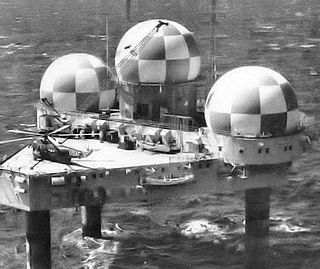 W
WThe American fiber helmet is a type of sun helmet made of pressed fiber material that has been used as part of the military uniform by various parts of the United States Armed Forces, from 1934 to present. As of 2017, the helmet continues to be worn by US military rifle range cadres, as an icon for marksmanship excellence. The helmet is technically not a pith helmet, insofar as it is not constructed from pith material. However, in the more generic sense of design style, this type of sun helmet is modeled similarly to one and thus often referred to in common use as a pith helmet. Additionally, the helmet is not a combat helmet, insofar as it was not originally designed to protect the head during combat. However, the helmet was nonetheless assigned, at various times in the 1930s and 1940s, as combat gear for use in active theaters.
 W
WATLAS-I, better known as Trestle, was the codename for a unique electromagnetic pulse (EMP) generation and testing apparatus built between 1972 and 1980 during the Cold War at Sandia National Laboratories near Kirtland Air Force Base in Albuquerque, New Mexico.
 W
WBunny boots or Mickey Mouse boots are the most common nicknames for the Extreme Cold Vapor Barrier Boots used by the United States Armed Forces. These large, bulbous, waterproof rubber boots can be worn in extremely cold weather, −20 to −60 °F, with the liner-free interior retaining warmth by sandwiching up to one inch of wool and felt insulation between two vacuum-tight layers of rubber; this vacuum layer insulates the wearer's feet similar to a vacuum flask. These boots were originally developed at the Navy Clothing and Textile Research Center in Natick, Massachusetts, for use during the Korean War.
 W
WThe Reeves AN/MSQ-77 Bomb Directing Central, Radar was a USAF automatic tracking radar/computer system for command guidance of military aircraft during Vietnam War bomb runs at nighttime and during bad weather. Developed from the Reeves AN/MSQ-35, the AN/MSQ-77 reversed the process of Radar Bomb Scoring by continually estimating the bomb impact point before bomb release with a vacuum tube ballistic computer. Unlike "Course Directing Centrals" which guided aircraft to a predetermined release point, the AN/MSQ-77 algorithm continuously predicted bomb impact points during the radar track while the AN/MSQ-77's control commands adjusted the aircraft course. A close air support regulation prohibited AN/MSQ-77 Combat Skyspot bombing within 1,000 yd (910 m) of friendly forces unless authorized by a Forward Air Controller, and "on several occasions" strikes were as close as 273 yd (250 m).
 W
WThe Peacekeeper Rail Garrison is a mobile missile system that was developed by the United States Air Force during the 1980s as part of a plan to place fifty MGM-118A Peacekeeper intercontinental ballistic missiles on the rail network of the United States. The railcars were intended, in case of increased threat of nuclear war, to be deployed onto the nation's rail network to avoid being destroyed by a first strike counterforce attack by the Soviet Union. However, the plan was cancelled as part of defense cutbacks following the end of the Cold War, and the Peacekeeper missiles were installed in silo launchers as LGM-118s instead.
 W
WThe Semi-Automatic Ground Environment (SAGE) was a system of large computers and associated networking equipment that coordinated data from many radar sites and processed it to produce a single unified image of the airspace over a wide area. SAGE directed and controlled the NORAD response to a Soviet air attack, operating in this role from the late 1950s into the 1980s. Its enormous computers and huge displays remain a part of cold war lore, and a common prop in movies such as Dr. Strangelove and Colossus.
 W
WThe Texas Towers were a set of three radar facilities off the eastern seaboard of the United States which were used for surveillance by the United States Air Force during the Cold War. Modeled on the offshore oil drilling platforms first employed off the Texas coast, they were in operation from 1958 to 1963. After the collapse of one of the towers in 1961, the remaining towers were closed due to changes in threat perception and out of a concern for the safety of the crews.